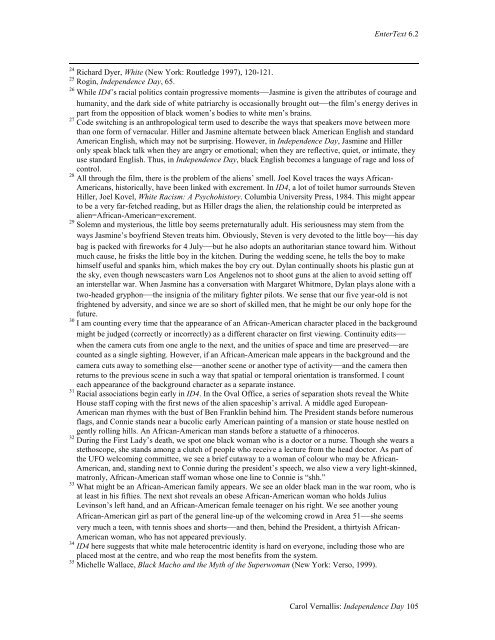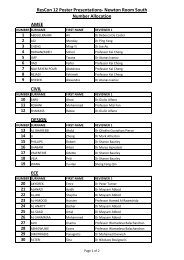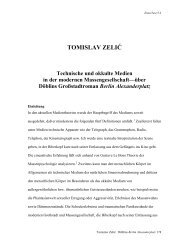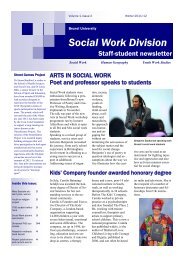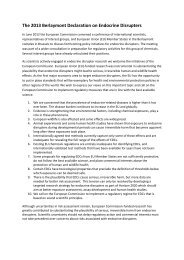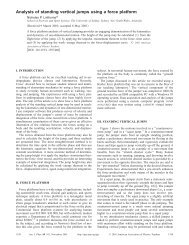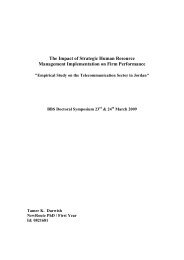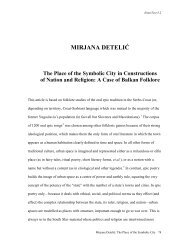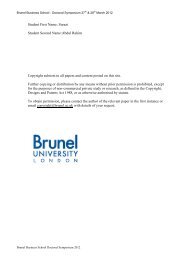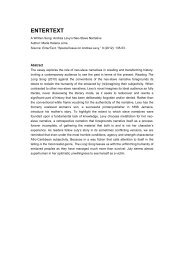Militarism, Misanthropy and the Body Politic: - Brunel University
Militarism, Misanthropy and the Body Politic: - Brunel University
Militarism, Misanthropy and the Body Politic: - Brunel University
Create successful ePaper yourself
Turn your PDF publications into a flip-book with our unique Google optimized e-Paper software.
EnterText 6.2<br />
24 Richard Dyer, White (New York: Routledge 1997), 120-121.<br />
25 Rogin, Independence Day, 65.<br />
26 While ID4’s racial politics contain progressive moments—Jasmine is given <strong>the</strong> attributes of courage <strong>and</strong><br />
humanity, <strong>and</strong> <strong>the</strong> dark side of white patriarchy is occasionally brought out—<strong>the</strong> film’s energy derives in<br />
part from <strong>the</strong> opposition of black women’s bodies to white men’s brains.<br />
27 Code switching is an anthropological term used to describe <strong>the</strong> ways that speakers move between more<br />
than one form of vernacular. Hiller <strong>and</strong> Jasmine alternate between black American English <strong>and</strong> st<strong>and</strong>ard<br />
American English, which may not be surprising. However, in Independence Day, Jasmine <strong>and</strong> Hiller<br />
only speak black talk when <strong>the</strong>y are angry or emotional; when <strong>the</strong>y are reflective, quiet, or intimate, <strong>the</strong>y<br />
use st<strong>and</strong>ard English. Thus, in Independence Day, black English becomes a language of rage <strong>and</strong> loss of<br />
control.<br />
28 All through <strong>the</strong> film, <strong>the</strong>re is <strong>the</strong> problem of <strong>the</strong> aliens’ smell. Joel Kovel traces <strong>the</strong> ways African-<br />
Americans, historically, have been linked with excrement. In ID4, a lot of toilet humor surrounds Steven<br />
Hiller, Joel Kovel, White Racism: A Psychohistory. Columbia <strong>University</strong> Press, 1984. This might appear<br />
to be a very far-fetched reading, but as Hiller drags <strong>the</strong> alien, <strong>the</strong> relationship could be interpreted as<br />
alien=African-American=excrement.<br />
29 Solemn <strong>and</strong> mysterious, <strong>the</strong> little boy seems preternaturally adult. His seriousness may stem from <strong>the</strong><br />
ways Jasmine’s boyfriend Steven treats him. Obviously, Steven is very devoted to <strong>the</strong> little boy—his day<br />
bag is packed with fireworks for 4 July—but he also adopts an authoritarian stance toward him. Without<br />
much cause, he frisks <strong>the</strong> little boy in <strong>the</strong> kitchen. During <strong>the</strong> wedding scene, he tells <strong>the</strong> boy to make<br />
himself useful <strong>and</strong> spanks him, which makes <strong>the</strong> boy cry out. Dylan continually shoots his plastic gun at<br />
<strong>the</strong> sky, even though newscasters warn Los Angelenos not to shoot guns at <strong>the</strong> alien to avoid setting off<br />
an interstellar war. When Jasmine has a conversation with Margaret Whitmore, Dylan plays alone with a<br />
two-headed gryphon—<strong>the</strong> insignia of <strong>the</strong> military fighter pilots. We sense that our five year-old is not<br />
frightened by adversity, <strong>and</strong> since we are so short of skilled men, that he might be our only hope for <strong>the</strong><br />
future.<br />
30 I am counting every time that <strong>the</strong> appearance of an African-American character placed in <strong>the</strong> background<br />
might be judged (correctly or incorrectly) as a different character on first viewing. Continuity edits—<br />
when <strong>the</strong> camera cuts from one angle to <strong>the</strong> next, <strong>and</strong> <strong>the</strong> unities of space <strong>and</strong> time are preserved—are<br />
counted as a single sighting. However, if an African-American male appears in <strong>the</strong> background <strong>and</strong> <strong>the</strong><br />
camera cuts away to something else—ano<strong>the</strong>r scene or ano<strong>the</strong>r type of activity—<strong>and</strong> <strong>the</strong> camera <strong>the</strong>n<br />
returns to <strong>the</strong> previous scene in such a way that spatial or temporal orientation is transformed. I count<br />
each appearance of <strong>the</strong> background character as a separate instance.<br />
31 Racial associations begin early in ID4. In <strong>the</strong> Oval Office, a series of separation shots reveal <strong>the</strong> White<br />
House staff coping with <strong>the</strong> first news of <strong>the</strong> alien spaceship’s arrival. A middle aged European-<br />
American man rhymes with <strong>the</strong> bust of Ben Franklin behind him. The President st<strong>and</strong>s before numerous<br />
flags, <strong>and</strong> Connie st<strong>and</strong>s near a bucolic early American painting of a mansion or state house nestled on<br />
gently rolling hills. An African-American man st<strong>and</strong>s before a statuette of a rhinoceros.<br />
32 During <strong>the</strong> First Lady’s death, we spot one black woman who is a doctor or a nurse. Though she wears a<br />
stethoscope, she st<strong>and</strong>s among a clutch of people who receive a lecture from <strong>the</strong> head doctor. As part of<br />
<strong>the</strong> UFO welcoming committee, we see a brief cutaway to a woman of colour who may be African-<br />
American, <strong>and</strong>, st<strong>and</strong>ing next to Connie during <strong>the</strong> president’s speech, we also view a very light-skinned,<br />
matronly, African-American staff woman whose one line to Connie is “shh.”<br />
33 What might be an African-American family appears. We see an older black man in <strong>the</strong> war room, who is<br />
at least in his fifties. The next shot reveals an obese African-American woman who holds Julius<br />
Levinson’s left h<strong>and</strong>, <strong>and</strong> an African-American female teenager on his right. We see ano<strong>the</strong>r young<br />
African-American girl as part of <strong>the</strong> general line-up of <strong>the</strong> welcoming crowd in Area 51—she seems<br />
very much a teen, with tennis shoes <strong>and</strong> shorts—<strong>and</strong> <strong>the</strong>n, behind <strong>the</strong> President, a thirtyish African-<br />
American woman, who has not appeared previously.<br />
34 ID4 here suggests that white male heterocentric identity is hard on everyone, including those who are<br />
placed most at <strong>the</strong> centre, <strong>and</strong> who reap <strong>the</strong> most benefits from <strong>the</strong> system.<br />
35 Michelle Wallace, Black Macho <strong>and</strong> <strong>the</strong> Myth of <strong>the</strong> Superwoman (New York: Verso, 1999).<br />
Carol Vernallis: Independence Day 105


